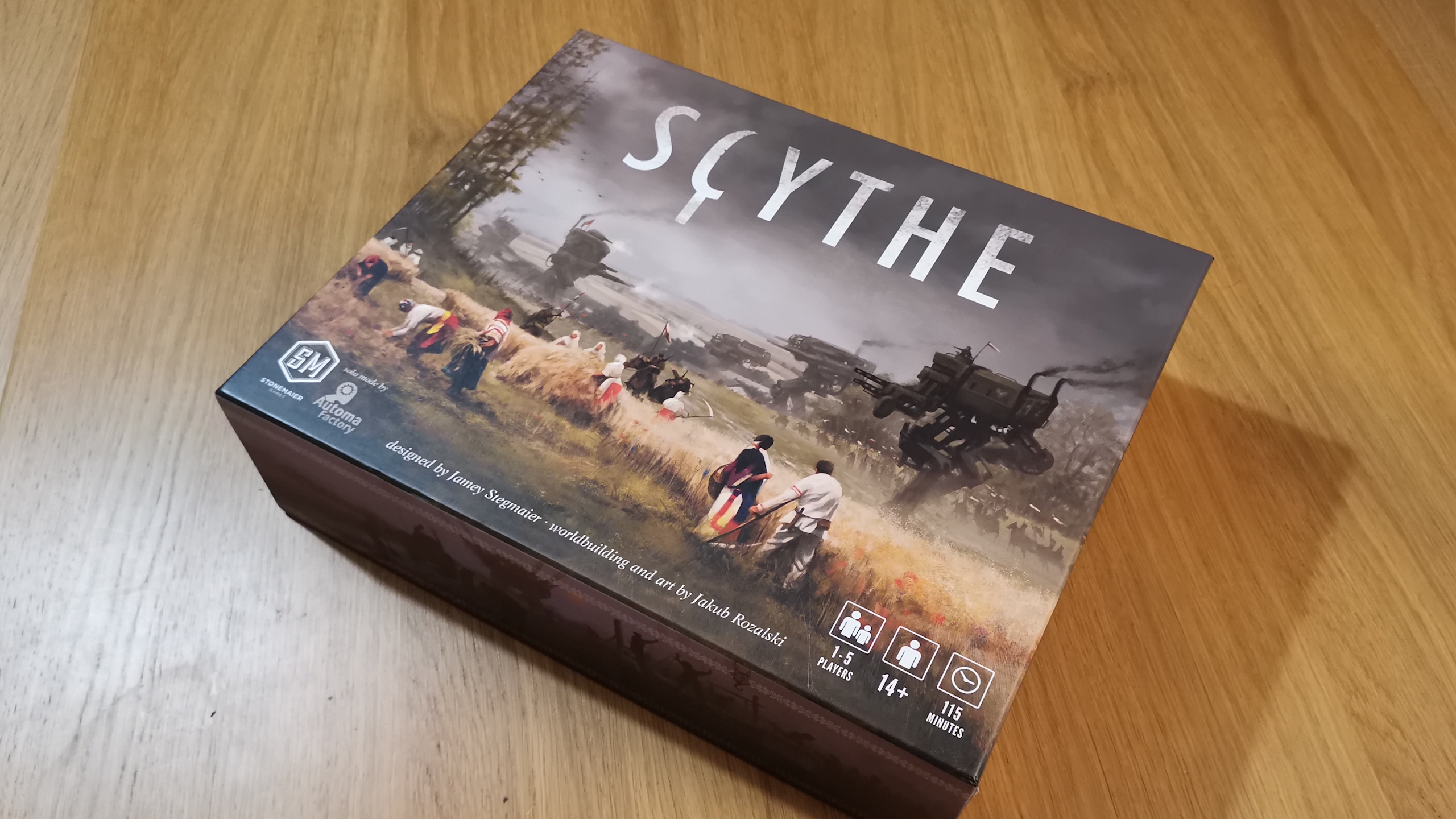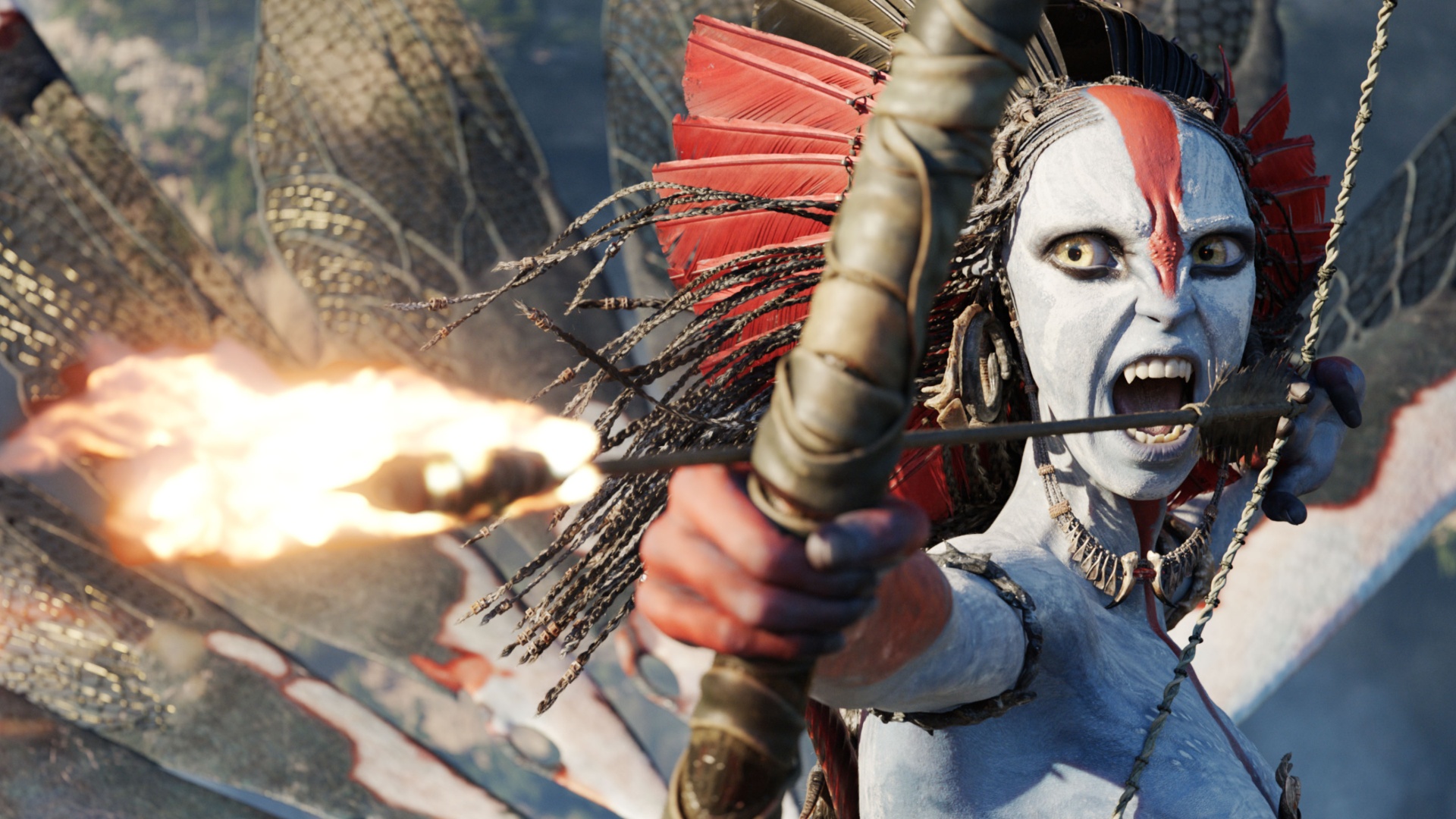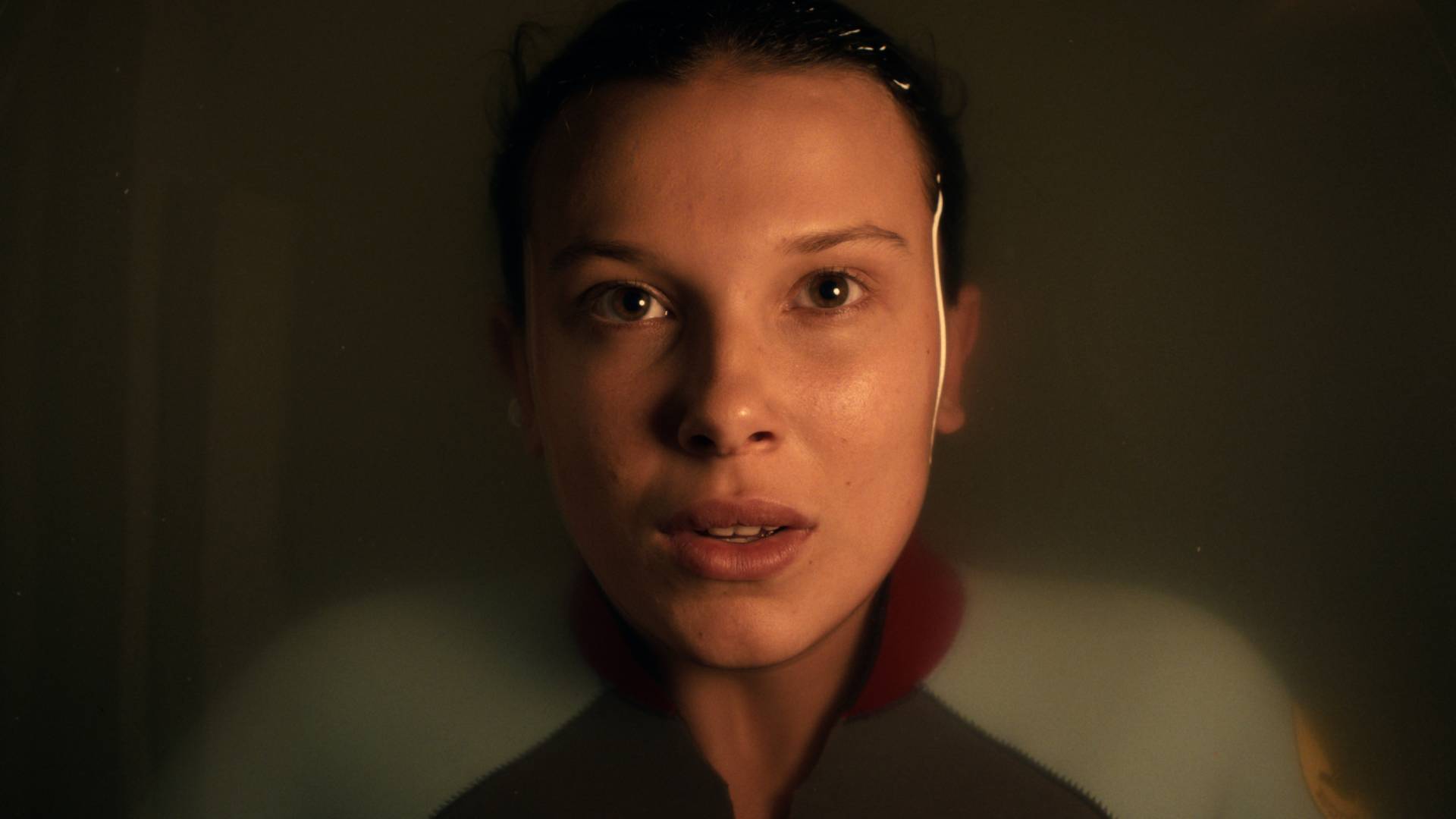GamesRadar+ Verdict
The best game in the Pandemic series yet, Fate of the Fellowship offers a thrilling, varied and thematic challenge, although you'll have to put up with the occasional boring or confusing turn.
Pros
- +
Impressively evocative of Tolkien's novel, both visually and thematically
- +
Challenging difficulty with lots of different strategies to explore
- +
Objective system gives it a strong narrative backbone and impressive replay value
Cons
- -
Occasional turns where you can do little or nothing
- -
Board can get quite cluttered and confusing
Why you can trust GamesRadar+
Back in 2008, Matt Leacock’s Pandemic launched the ongoing craze for cooperative games where the players work together to beat the system rather than against each other. But Pandemic itself was partly inspired by an earlier cooperative game by prolific German designer Reiner Knizia called Lord of the Rings and based, of course, on Tolkien's epic fantasy novel. In a surprising closure of this ring, Leacock has now created his own take on a cooperative Middle-earth game by adapting the Pandemic system in Fate of the Fellowship.
So, can this spiritual sequel live up to everything that came before? Considering how beloved Pandemic continues to be (it's on many lists of the best board games for a reason), that's going to be a tall order... but it's one Fate of the Fellowship is able to meet.
Fate of the Fellowship features & design
Price | $79.99 / £69.99 |
Ages | 14+ |
Game type | Area control / cooperative |
Players | 1 - 5 |
Lasts | 60 - 150mins |
Complexity | Moderate |
Designers | Matt Leacock |
Publisher | Z-Man Games |
Play if you enjoy | Pandemic, Horrified, Forbidden Island, Lord of the Rings: Duel for Middle-earth |
- Includes an incredible cardboard dice tower & cool custom dice
- Lots of fantastic wooden pieces, although the cards are flimsy
- Everything fits nearly into a sensibly-sized box
Unboxing Fate of the Fellowship is a slow reveal of things secret and safe. You take off the unassuming lid with its fairly unassuming box art and beneath there’s a folded-away board and some sheets of punch-out card. The first clue that all is not what it seems comes alongside the rulebook, with a separate set of instructions to assemble a cardboard dice tower that resembles the dark lord Sauron’s stronghold of Barad-dur as seen in Peter Jackson’s film treatment of the novels, complete with un-canonical disembodied eye.
Canonical or not, the finished tower is a sight to behold, sturdy with cardboard layers and bristling with battlements. It’s entirely unnecessary, as you’re free to roll your dice on the table, but it looks incredible. As do the dice, two sets of marbled custom cubes, one in white for resolving battles and another in black for when wraiths are hunting for the ring. The tower can be partially disassembled to fit neatly into the box, which snugly organizes so many components that it feels like a cardboard Tardis.
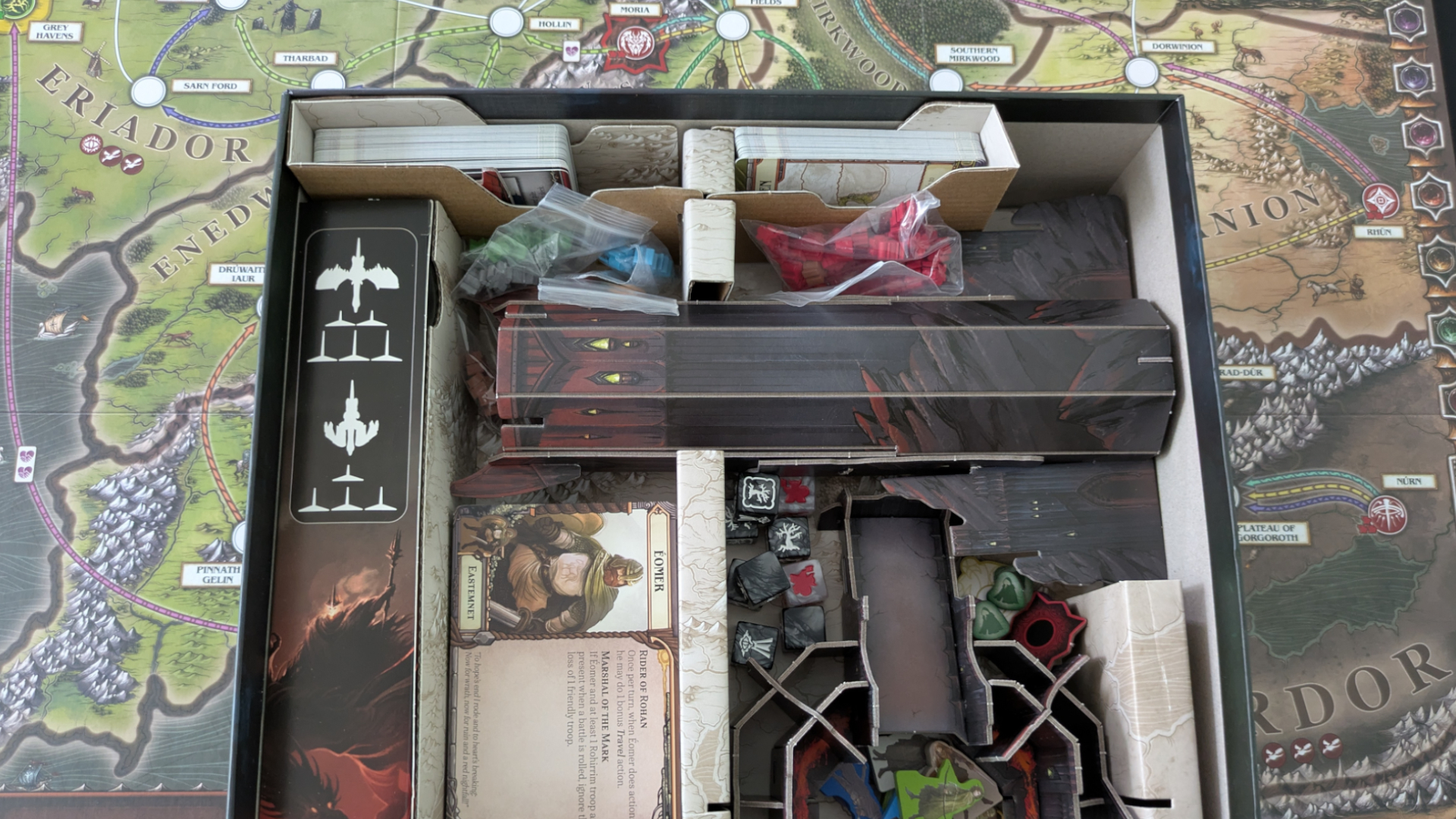
And there are surprises still to come. Unfold the board and find a delightful, if visually confusing, map of Middle-Earth, criss-crossed with borders and movement arrows and studded with towns and havens. Fish in the side pockets and you’ll discover a small army of tiny meeples in various colours to depict friendly and enemy troops, so miniscule that it’s actually quite difficult to tell whether they’re standing right-side up. Open the cardboard envelope to reveal bigger wooden standees for player pieces, printed with identifying artwork. Last, but not least, in a lidded section there are detailed plastic Ringwraith miniatures on transparent flying stands.
Finally we come to various decks of cards. Some, those used for controlling enemy movement and events, alongside character and objective cards, are tarot-sized. The remainder, which are region cards, are normal playing-card size. They’re the most disappointing things among the contents, feeling a little flimsy and lacking much in the way of art. But that’s a minor complaint when they are clear and accessible, with the necessary information on them well laid out and easy to reference during play.
Gameplay
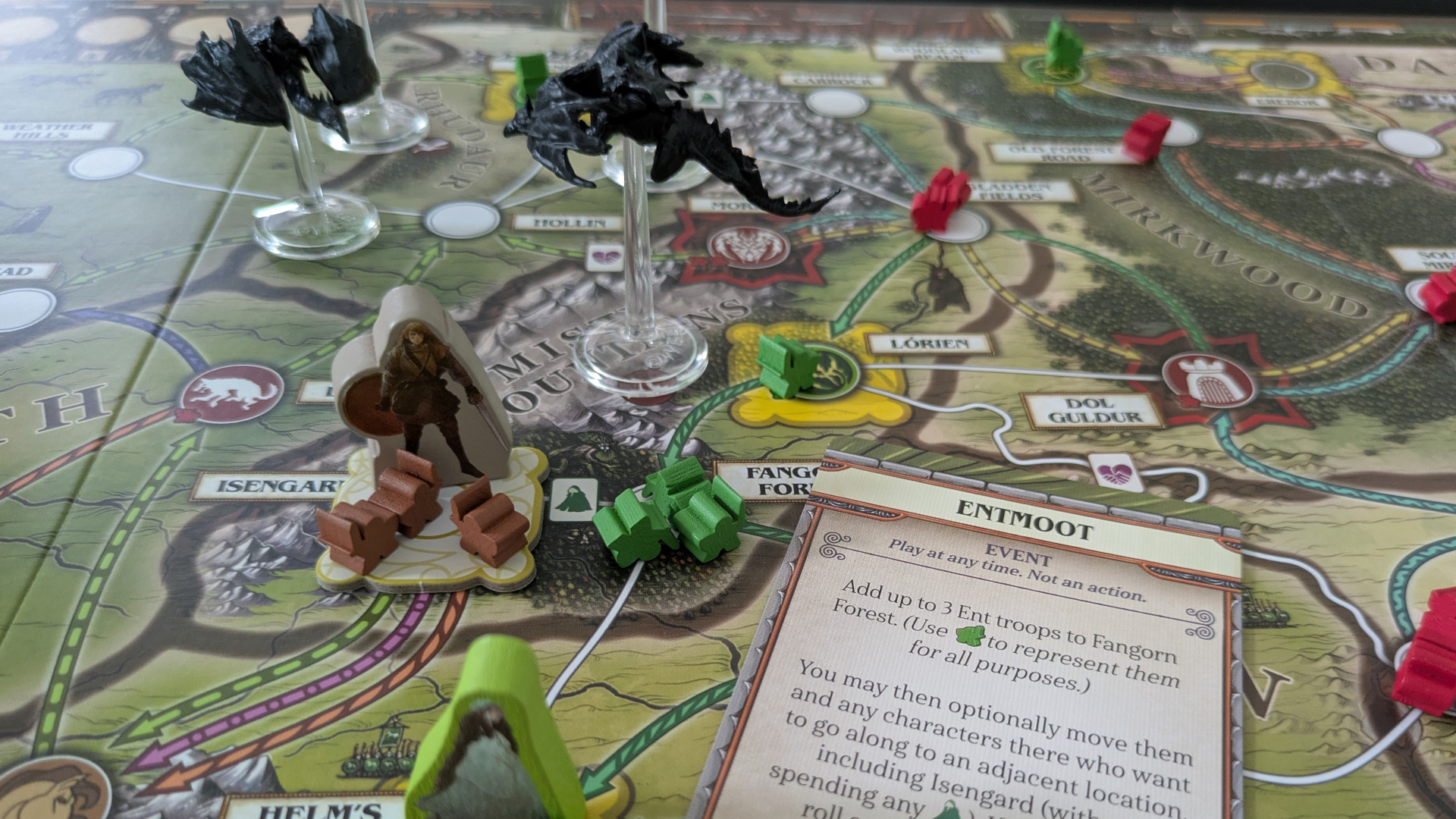
- Cooperate to fulfill four objectives based on plot points from the novels
- Shadow cards cause enemy troops to move & attack havens
- Ringwraiths amass in different regions & make movement there dangerous
Although Fate of the Fellowship is based on Leacock’s cooperative game Pandemic, which has spawned a number of spin-offs over the years, it’s by far the most ambitious and complex take on the system, which is barely recognisable under layers of theme. In most setups, players will take on the role of two characters from the book, each of whom has various special abilities. On their turn, in an immediate tactical conundrum, they’ll choose one of those characters to take four actions, and take one action with the other. You’ll also have a hand of cards, each of which is tied to a region of the board and bears a symbol reflecting a type of action: friendship, stealth, valor, and resistance.
Weekly digests, tales from the communities you love, and more
Your choice of options is fairly narrow. One is to travel from one location to another, taking along any troops or other players' pieces if they agree to go, for free. Player pieces can travel along any route, including arrows, in any direction, although some are printed with symbols that require you to spend a matching card. When Frodo moves with the ring, however, there’s an additional danger. Unless he spends a stealth token, he has to roll a search dice for each Ringwraith in his region. This can lead to the group losing “hope” which will cause them to lose the game if it drops to zero, and introduces a fascinating risk versus reward decision to movement, depending on where the wraiths are gathered.
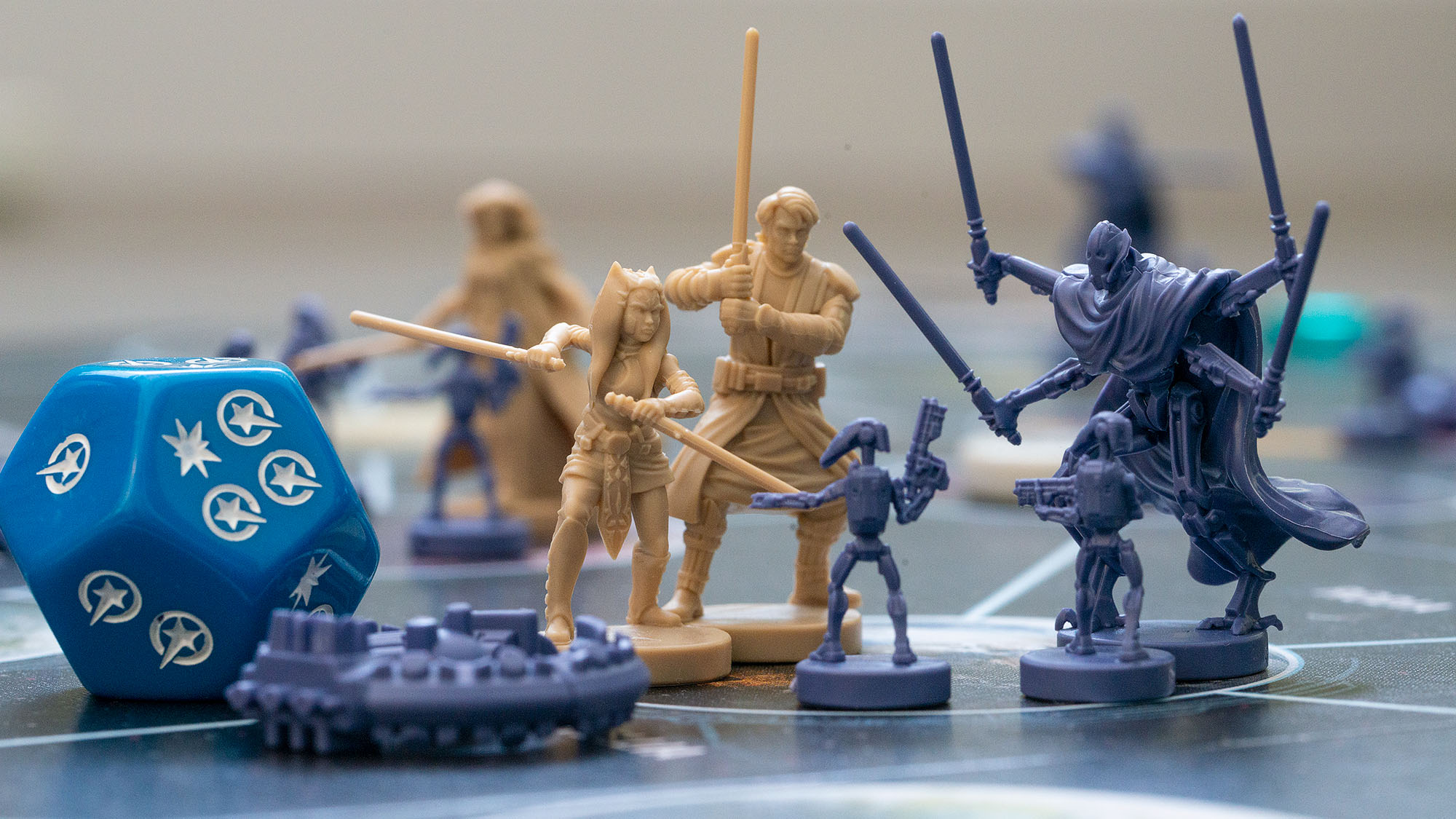
There are plenty of spin-off games inspired by Pandemic, be it a Cthulhu themed version or one based in the Cold War. However, Fate of the Fellowship has the most in common with Pandemic World of Warcraft and Star Wars: The Clone Wars Pandemic. Both use troops and the former relies on quests to help it stand out.
Other actions include Muster, which lets you add a friendly troop to the board if you’re at a mustering point and spend a friendship card. Then there's Attack, which starts a fight if you’ve brought friendly and enemy troops together at a location. Capture allows you to take over an empty enemy stronghold and make it friendly when you spend a valor card, on the other hand, while Fellowship allows two players with pieces at the same location to swap cards. The final action is Prepare which lets you discard a card to gain a token of the matching icon, which is helpful to stop you running afoul of the seven-card hand limit.
Once you’ve taken all your actions you gain two new region cards from the deck and then you draw shadow cards. These either move groups of enemy armies across the board along the indicated arrow paths, or add more troops to the board and move Ringwraiths around. Neither is good news. You start out drawing two at the end of a player’s turn but mixed into the region deck are "skies darken" cards which slowly increase the number of shadow cards drawn each turn and, worse, force you to reshuffle the discarded shadow cards and slap them back atop the draw deck. This means that armies already on the move are likely to move again, drawing closer to their targets.
Make no mistake: just like in the book, the advance of Sauron’s armies is inexorable. You can win individual victories against them, and some character powers let you pick them off here and there, but they will advance with the inevitability of time and tides. There’s a real visual aspect to this as the huge number of red enemy meeples on the board just keeps on swelling and advancing, feeling more like a living enemy than a card-controlled contrivance, dwarfing the tiny proportion of friendly armies and pressing all the players with growing panic as they move faster and faster as the skies darken and the game progresses. Eventually they will begin to swallow their targets such as Rivendell or the Shire. Whenever this happens you lose two hope and the end of all things draws nigh.
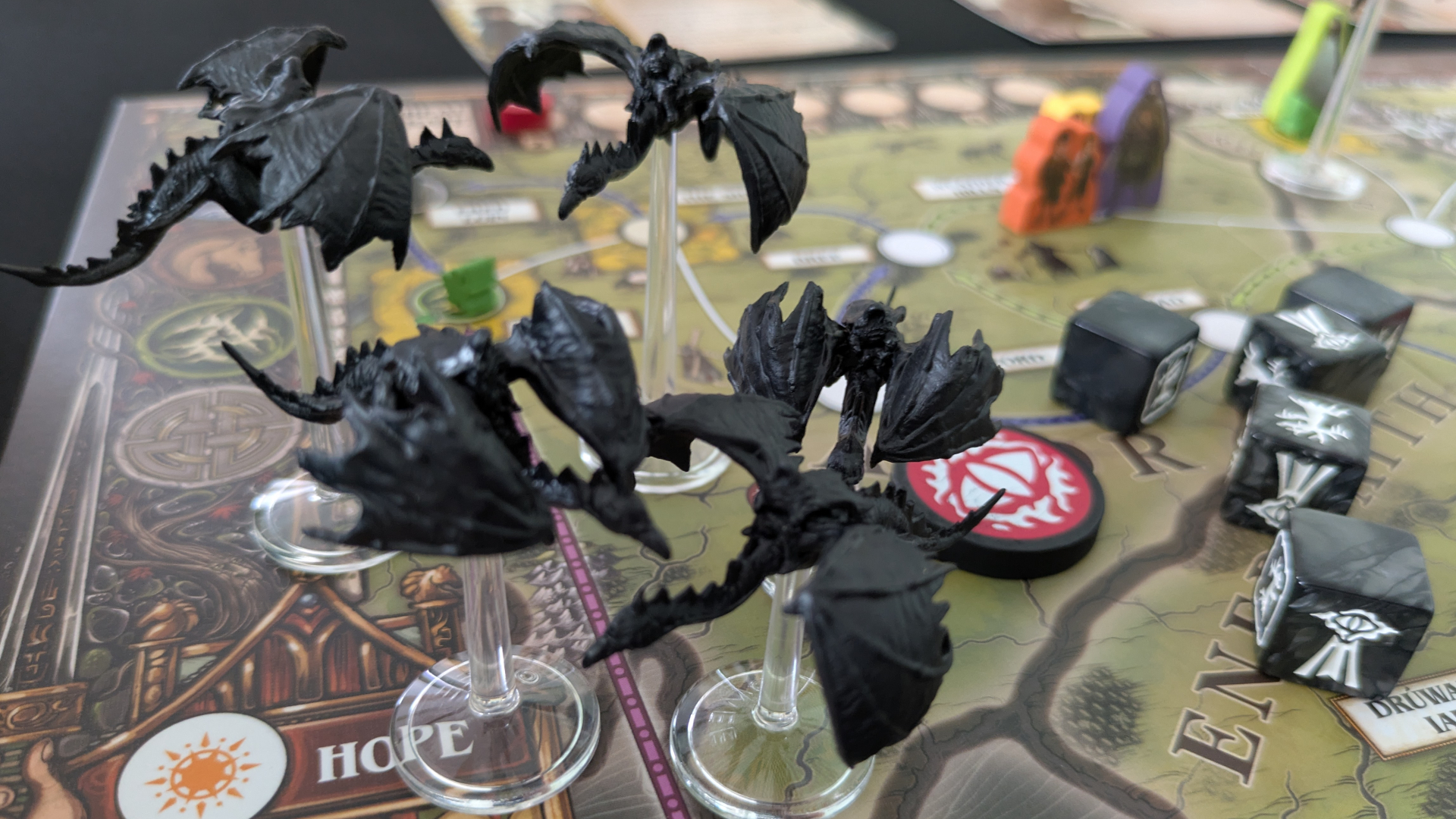
How, then, are you to beat the inevitable and win? The answer, just like the book, is to guide Frodo to Mount Doom and have him throw the ring into the fires that made it. In game terms this is represented by an objective card, Destroy the One Ring, which needs Frodo to be at the right place, have five resistance symbols to spend, and, to inject some tension into the finale, roll a bunch of search dice. This objective is used in every game but, in a clever twist, the others you must fulfill as a precursor to this final quest are up to you, all based on plot beats from the story.
In the basic setup you have to ally with the elves at Rivendell, clear evil Saruman out of his wizard’s tower and capture it, then challenge the dark lord with a mix of friendly forces outside his gates. But if instead you want your game to involve freeing the king of the horse-lords from his insidious adviser, confronting that hideous fire-demon the Balrog in its underground lair, or even just have elven warrior Legolas complete his tally of dead orcs, you can use those, or many more, instead. All require having certain characters in certain places and spending certain cards. In one fell swoop, objective cards allow you to customize the game and difficulty to your liking, vary hugely the required strategies to win, and bring the whole edifice to life with narrative flavour. They’re things of absolute genius.

I was able to catch up with developer Matt Leacock for an interview ahead of the game's launch, and he said that Fate of the Fellowship is "definitely the most thematically and mechanically rich game I’ve worked on."
We’ve come a long way down now, and still not talked a lot about those strategic choices. And that’s partly because this is a fairly complex game that takes some describing and partly because the choices vary so much with the objectives. Since destroying the ring is always on the cards, you’ll need to find a way to load Frodo up with ring symbols. And whatever you need to do to complete your other objectives, you’ll also have to slow the terrible advance of the shadow armies. Just like in the original Pandemic, this essentially involves the skills of crisis management, learning to judge when one looming problem needs to be dealt with and another can safely be left for another turn or two. And just like in the original Pandemic, the decks of cards will do their best to thwart you. However, there are a lot more moving parts to this version, which means making the correct calls is that much more difficult.
It is not without its flaws. Once things get moving the board gets packed with pieces. There are often more shadow troops in a space that can fit, spilling over and obscuring all that important information printed on the board. Most pieces move by location but wraiths move and attack by region, so you can sometimes forget to include them when you’re supposed to. And their flying stands further crowd the board and have an infuriating habit of falling over when you reach across to move something else.
Worse, however, is that the requirement of needing certain card symbols to do a lot of things, from taking particular pathways to fulfilling objectives, and this means there are occasional turns where players simply can’t use all their actions for want of the right cards and are left twiddling their thumbs. It's often too risky to move Frodo, for example, if he has no stealth cards and if he's not in a haven there's not much else to do with his actions. This is enormously frustrating and a little bit dull whenever it happens.
Should you buy Fate of the Fellowship?

Pandemic is now a very well-worn system, not only in terms of the base game, expansion and spinoffs, but various other games that have taken inspiration from its concepts. As such, it’s tempting to overlook yet another game with the branding on the box, but that would be a mistake. This is a more challenging, more varied, more thematic and, overall, simply a better game than its parent and it easily feels fresh enough to justify anyone with any interest taking a look, even if they’re a veteran of a dozen Pandemic clones.
It won’t, however, win over anyone that’s not a fan of cooperative play as a broad concept. Lots of modern cooperative designs use things like hidden information or individual objectives to try and spice up the experience. There’s none of that here. In the same vein, such designs have also tended to tilt toward family-friendly play with fast, easy designs, whereas Fate of the Fellowship is long and moderately complex.
Fans of Tolkien's masterwork, though, should definitely check this out as it brings his world vividly to life through both the components and the mechanics, with each play delivering a satisfying variation on the book’s narrative.
Ratings
Criteria | Notes | Score |
|---|---|---|
Game mechanics | You’d never imagine mechanics about curing disease would adapt so well to Tolkien's world, but it’s effectively thematic and provides a solid balance of excitement and strategic choice. | 4/5 |
Accessibility | Although not overwhelmingly complex, this is a step up from the original Pandemic, and the over-crowded board can make it hard to administer. | 3/5 |
Replayability | Fate of the Fellowship’s objective system gives it huge replay value, with every combination needing a fresh strategic approach. | 5/5 |
Setup and pack-down | You'll end up with a lot of tokens sprawling across the board, so there's a good amount to put away when all is said and done. | 3/5 |
Component quality | The dice tower is an absolute delight, as are the wooden and plastic pieces, but the card decks are plain and a little flimsy. | 4/5 |
Buy it if...
✅ You're a Tolkein fan
The Fellowship were working together to defeat the dark lord, so not only is this an evocative setup, it looks great, and its fantastic objective system means you can revisit all your favourite plot points from the story to create your own realistic narrative of the books’ events.
✅ You’re bored of Pandemic clones
A lot of games riffed hard on the original Pandemic, but few of them did anything different enough to warrant much attention - especially given how popular and how frequently played the original was. This feels novel in comparison and will likely refresh your jaded palette.
Don't buy it if...
❌ You want a fast, family-friendly title
The original Pandemic, alongside many cooperative games, feel like a great fit for families as they cause minimal arguments, but this is a fairly long, fairly complex undertaking that’s better suited for more committed gamers.
❌ You’re not a fan of cooperative games in general
A lot of modern cooperative titles mix things up to stop an experienced or bossy player from ruling the roost but there’s no such effort here, so if you’re not a fan of working together, this won’t do anything to change your mind.
How we tested Fate of the Fellowship
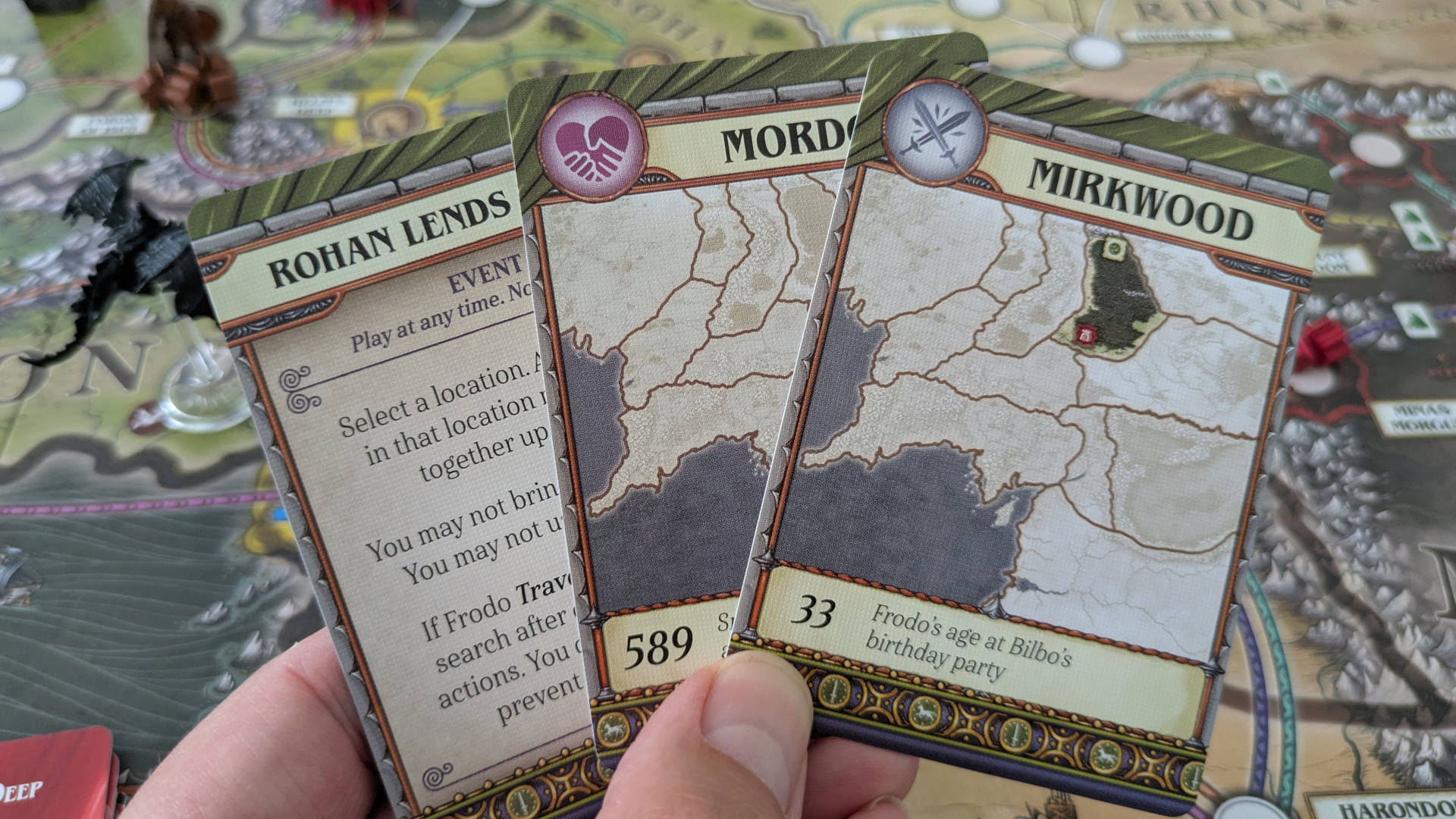
This review was conducted using a sample provided by the publisher.
After working through the rules in full and analysing them, our reviewer played Fate of the Fellowship multiple times to get a sense for its longevity and impact under different circumstances. The writer is also an experienced tabletop games critic with many years of work under their belt, so they utilized that knowledge to compare and contrast this game's systems with other, similar titles.
For a more in-depth look at our procedure, don't miss this guide to how we test board games or the full GamesRadar+ reviews policy.
Want more recommendations? Be sure to check out the best family board games, or the best adult board games.

Matt is a freelance writer specialising in board games and tabletop. With over a decade of reviews under his belt, he has racked up credits including IGN, Dicebreaker, T3, and The Guardian.
You must confirm your public display name before commenting
Please logout and then login again, you will then be prompted to enter your display name.

